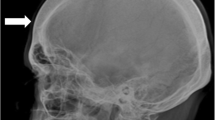Abstract
Background
Current thalassemia major treatment includes blood transfusion and iron chelation, which is associated with growth disturbances and radiographic changes in the long bone metaphyses.
Objective
To explore and discuss the spectrum of deferoxamine-induced bone-dysplasia-like changes in children with thalassemia major in Egypt.
Materials and methods
We studied 59 Egyptian children with thalassemia major and generalized arthralgia. All started deferoxamine treatment at 3 years of age. We conducted skeletal survey and MRI of both knees in radiographically positive children. Each child’s age, serum ferritin, age of onset and duration of therapy were compared with the radiologic findings.
Results
Twenty-two (37.3%) children had variable degrees of skeletal dysplasia-like changes similar to those described with deferoxamine intake, mostly around the knees. Mild dysplasia-like changes were seen in 4 (18%) children; moderate changes were seen in 11 (50%) children and severe changes were seen in 7 (31.8%) children. No statistically significant relationships were detected between bone changes and the children’s age, age of starting deferoxamine, duration of therapy, or serum ferritin level.
Conclusion
A wider spectrum of deferoxamine-induced bone-dysplasia-like changes was recognized despite delayed onset and small doses of therapy. These changes should be considered as a possible cause of arthropathy in children with thalassemia major, especially symptomatic children.





Similar content being viewed by others
References
Olivieri NF, Brittenham GM (1997) Iron-chelating therapy and the treatment of thalassemia. Blood 89:739–761
Chand G, Chowdhury V, Manchanda A et al (2009) Deferiprone-induced arthropathy in thalassemia: MRI findings in a case. Indian J Radiol Imaging 19:155–157
De Virgiliis S, Congia M, Frau F et al (1988) Deferoxamine-induced growth retardation in patients with thalassemia major. J Pediatr 113:661–669
Hartkamp MJ, Babyn PS, Olivieri F (1993) Spinal deformities in deferoxamine-treated homozygous beta-thalassemia major patients. Pediatr Radiol 23:525–552
Brill PW, Winchester P, Giardina PJ et al (1991) Deferoxamine-induced bone dysplasia in patients with thalassemia major. AJR Am J Roentgenol 156:561–565
Orinoco C, Scutellari PN, Castaldi G (1992) Growth plate injury of the long bones in treated betathalassemia. Skeletal Radiol 21:39–44
De Sanctis V, Pinamonti A, Di Palma A et al (1996) Growth and development in thalassaemia major patients with severe bone lesions due to desferrioxamine. Eur J Pediatr 155:368–372
Olivieri NF, Koren G, Harris J et al (1992) Growth failure and bony changes induced by deferoxamine. Am J Pediatr Hematol Oncol 14:48–56
Arman MI, Bektas S (1989) Rheumatologic findings in patients with major and intermediate beta-thalassemia. Z Rheumatol 48:68–72
Naselli A, Vignolo M, Di Battista E et al (1998) Long-term follow-up of skeletal dysplasia in thalassemia major. J Pediatr Endocrinol Metab 3:817–825
Miller TT, Caldwell G, Kaye JJ et al (1993) MR imaging of deferoxamine-induced bone dysplasia in an 8-year-old female with thalassemia major. Pediatr Radiol 23:523–524
Chan Y, Li C, Chu WC et al (2000) Deferoxamine-induced bone dysplasia in the distal femur and patella of pediatric patients and young adults: MR imaging appearance. AJR Am J Roentgenol 175:1561–1566
Chan Y, Li C, Pang L et al (2002) Patterns of bone diseases in transfusion-dependent homozygous thalassemia major: predominance of osteoporosis and desferrioxamine-induced bone dysplasia. Pediatr Radiol 32:492–497
Munk PL, Helms CA, Holt RG (1989) Immature bone infarcts: findings on plain radiographs and MR scans. AJR Am J Roentgenol 152:547–549
Jaramillo D, Shapiro F (1998) Growth cartilage: normal appearance, variants and abnormalities. Magn Reson Clin N Am 6:455–471
Chan Y, Li C, Pang L et al (2002) Desferrioxamine-induced long bone changes in thalassaemic patients—radiographic features, prevalence and relations with growth. Clin Radiol 55:610–614
Lederman HM, Cohen A, Lee JW et al (1984) Deferoxamine: a reversible S-phase inhibitor of human lymphocyte proliferation. Blood 64:748–753
Estrov Z, Tawa A, Wang XH et al (1987) In vitro and in vivo effects of deferoxamine in neonatal acute leukemia. Blood 69:757–761
Author information
Authors and Affiliations
Corresponding author
Rights and permissions
About this article
Cite this article
Seif El Dien, H.M., Esmail, R.I., Magdy, R.E. et al. Deferoxamine-induced dysplasia-like skeletal abnormalities at radiography and MRI. Pediatr Radiol 43, 1159–1165 (2013). https://doi.org/10.1007/s00247-013-2645-x
Received:
Revised:
Accepted:
Published:
Issue Date:
DOI: https://doi.org/10.1007/s00247-013-2645-x



